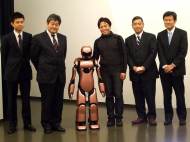E-nuvo HUMANOID robot to be used in educational purposes
 We’re glad the development of humanoid robots made for help or entertainment hasn’t ceased yet. Nippon Institute of Technology (NIT), Harada Vehicle Design, ZMP, and ZNUG Design have developed a humanoid robot for educational purposes in order to offer their students a better access to robot development. The university adopted 35 of ZMP’s e-nuvo WALK robots in 2004 for a 1:1 student-robot ratio. Whereas the ZMP e-nuvo WALK (the educational version of nuvo) is quite small, the new robot is tall enough to interact with its environment in a more meaningful way. Students will demonstrate the robot at elementary and junior high schools, as well as care facilities.
We’re glad the development of humanoid robots made for help or entertainment hasn’t ceased yet. Nippon Institute of Technology (NIT), Harada Vehicle Design, ZMP, and ZNUG Design have developed a humanoid robot for educational purposes in order to offer their students a better access to robot development. The university adopted 35 of ZMP’s e-nuvo WALK robots in 2004 for a 1:1 student-robot ratio. Whereas the ZMP e-nuvo WALK (the educational version of nuvo) is quite small, the new robot is tall enough to interact with its environment in a more meaningful way. Students will demonstrate the robot at elementary and junior high schools, as well as care facilities.
The e-nuvo HUMANOID robot is 126cm (4′) tall and weighs 15kg (33 lbs). Each of its leg has 6 degrees of freedom (DoF), each arm has 3 DoF and its head has 3 DoF, making a total of 21 DoF of the robot. It is equipped with the usual sensors including cameras, accelerometers, gyro sensors, obstacle detection sensors, distance sensors, and piezoelectric sensors. The robot is powered by a Lithium Ion battery.
Although it looks unstable while using hand gestures, and it obviously needs a better algorithm for walking, it is up to the students to work on further development of the robot in order to improve its features.
Besides basic speech capabilities, the robot can serve as a kind of teacher’s assistant, since it has a built-in projector which will allow it to display diagrams on a blackboard that might be difficult to explain in words alone. The robot will be programmed using Microsoft Robotics Developer Studio, which the students have been using to test control algorithms for the e-nuvo WALK robots.
The goal is to improve student learning by raising awareness of bipedal robot technology and its connection to math and physics, while also giving them hands-on experience with the robot. Additionally, by visiting care facilities the university students will come to understand the real-world needs and applications for robots. Since it has a built in projector and speaking ability, it may also prove useful as a presentation assistant in the future.









Leave your response!